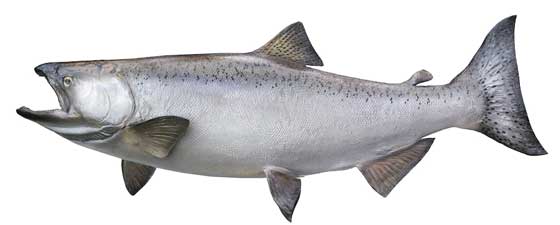Chinook Salmon Features and Size

How to recognize the Chinook or King Salmon
They have a deep blue-green back with silvery sides and a white belly. You’ll notice black irregular spots on the back, dorsal fin and both lobes of the tail.
They have small eyes, black gum coloration, a thick caudal peduncle and 13-19 anal rays.
When Spawning
Both males and females develop a reddish hue on their sides, although males may be deeper in color. Males are also distinguished by a hooked nose and a ridged back.
The Chinook fry however look very different. They have well developed parr marks on their sides. The marks on the side of the parr, which resemble those on a spotted bass, help it hide from predators. These marks disappear by the time they reach adulthood.
The process of undergoing physical changes so that it can enter salt water is known as smolting. Just before heading off to the sea, the parr gets a new paint job, losing its painted lines on its side.
These lines are replaced with the dark back and light belly coloration used by fish living in open water.
Habitat preferences change as well as they seek out deeper water and avoid light. Their gills and kidneys begin to change so that they can process salt water.
King Salmon don’t immediately go straight for the ocean. They stop off in estuaries for several months before heading off the the sea.
Size
The Chinook (King) Salmon is the largest of all Pacific salmon species. They can often be caught at 100 pounds or larger and can be longer than a massive 5 feet.
In fact, one was caught near Petersburg, Alaska in 1949. This particular fish was caught using a net but it doesn’t take away from the sheer size of this fish.
They are absolutely massive.



